9 Funky Fruits You Have to Try
When was the last time you picked up a fruit that had an unpronounceable name and promised complete unknown within? If you enjoy exploring new tastes, here are 9 funky fruits you have to try.
1) Rambutan, Malaysia/Indonesia
Rambutanmessy haired fruit with juicy white flesh. Photo by kool.angot.
Inside, the fruit is like a larger, juicier version of a lychee, with soft white flesh and an inedible seed. It is easy to peel and usually eaten raw or added to fruit salad. Make sure the skin is red for ripeness and the hair isnt black.
2) Jackfruit, India
Jackfruitthe largest fruit to be plucked from trees. Photo by abcdz2000.
It has a tangy banana flavor and its consistency is fibrous with a starchy flesh, which, when it is less ripe, makes a great chicken substitute in Sri Lankan and Eastern Indian curries. Sweet fans can put jackfruit in custards and cakes or eat it as dried chips.
3) Kiwano, Africa
Kiwanoan indecisive fruit that is a cross between a melon, cucumber, banana and lemon. Photo byV31S70.
In its native land, the Kiwano is eaten as a snack or in salad while in other countries its vibrant skin is regularly used to garnish dishes as well as being an edible fruit. All parts, including the seeds and skin, are edible, though it is more common to eat only the pulp.
4) Fingered Citron, Northeast India/China
Fingered citron, otherwise known as Buddhas hand. Photo by xeni.
The fingers stretch around four to six inches in length and despite its often seedless and juiceless attributes, it has still been put to edible use by being candied or used as zest in cooking. The rind can also be added to salad or fish.
5) Ackee, West Africa
AckeeJamaican staple, great with saltfish. Photo by DrewToYou.
Ackee with saltfish is Jamaicas national dish and is popular at breakfast. Beware, though, the fruit is toxic when unripe. Even when ready to eat, it is fully cleaned and boiled for half an hour.
6) Durian, Indonesia/Malaysia
Durianlove it or hate it, everyone should try it . . . at least once. Photo by YIM Hafiz.
Do, however, be careful where you try the fruit as it is banned in some hotels. Durian is eaten raw and also added to ice cream, cakes and even cappuccino.
7) Pitaya, Mexico/Central America
Pitaya, otherwise known as dragon fruit, great in a smoothie. Photo by chooyutshing.
Only the flesh is eaten and is similar in taste to melon or kiwi with a delicate flavor. The fruit has a high water content and is often eaten raw or juiced. The fruit is also known for its flowers, which can be used to make tea.
 Mangosteen, Malaysia
Mangosteen, Malaysia
Mangosteenno, thats not a garlic bulb inside. Photo by su-lin.
Be careful as seeds are tucked inside each of the segments and are bitter. The flesh is most often eaten raw, and in countries where there are restrictions on imports, mangosteen can sometimes be found canned or frozen.
9) Ugli, Jamaica
Ugli fruit . . . but tasty fruit. Photo by Oggie Dog.
The fruits taste is a combination of the sourness of grapefruit, the robustness of an orange and the tangy taste of a tangerine. When ripe, its slack brown skin morphs to orange and is sweeter than its tangerine and grapefruit relatives. It is versatile enough for salads, cheesecake and marmalade.





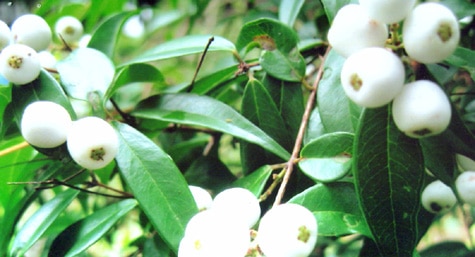
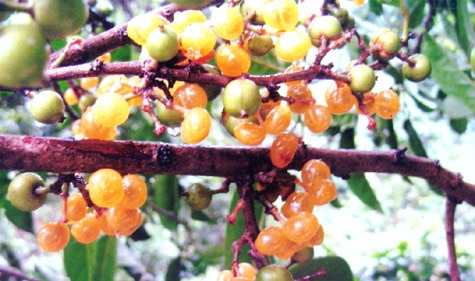
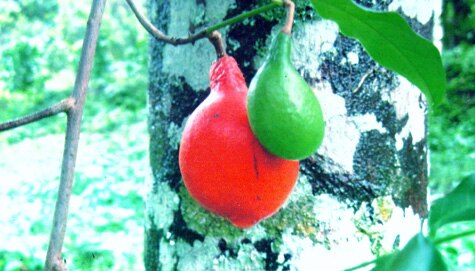
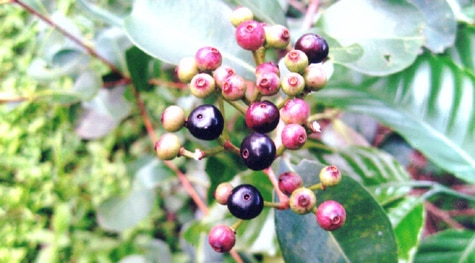
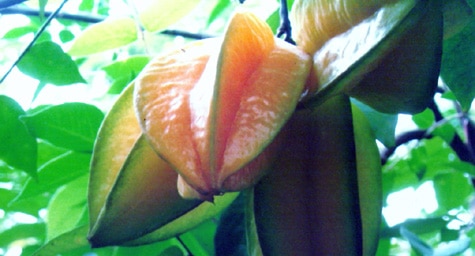

 Reply With Quote
Reply With Quote


 കേരളത്തിന്റെ സ്വന്തം പൂമരമാണ് ഐശ്വര്യത്തിന്റെ പ്രതീകമായി കണക്കാക്കുന്ന കണിക്കൊന്ന. വലിയ ഇലയാണെങ്കിലും പൂക്കാലത്തോടെ അവ പൊഴിയും. പ്രധാന പൂക്കാലം മാര്*ച്ച്-ഏപ്രില്* മാസമാണ്. പക്ഷേ ഇപ്പോള്* കാലം തെറ്റി പൂക്കാറുണ്ട്.
കേരളത്തിന്റെ സ്വന്തം പൂമരമാണ് ഐശ്വര്യത്തിന്റെ പ്രതീകമായി കണക്കാക്കുന്ന കണിക്കൊന്ന. വലിയ ഇലയാണെങ്കിലും പൂക്കാലത്തോടെ അവ പൊഴിയും. പ്രധാന പൂക്കാലം മാര്*ച്ച്-ഏപ്രില്* മാസമാണ്. പക്ഷേ ഇപ്പോള്* കാലം തെറ്റി പൂക്കാറുണ്ട്. മഞ്ഞവാക
മഞ്ഞവാക ചെമ്പകം സാമാന്യം ഉയരമുള്ള മരങ്ങളുടെ ത്രികോണാകൃതിയും സുഗന്ധമുള്ള പൂക്കളും ശ്രദ്ധേയമാണ്. നീണ്ട് വലിപ്പമുള്ള ഭംഗിയുള്ള ഇലകള്* മരത്തിന് ഗാംഭീര്യം പകരുന്നു. ഇളംമഞ്ഞയോ ഓറഞ്ചോ നിറമാണ് പൂക്കള്*ക്ക് . വേനലിലും മഴയത്തും പൂക്കുന്നു. പാതയോരത്ത് നടാനും ഉത്തമം.
ചെമ്പകം സാമാന്യം ഉയരമുള്ള മരങ്ങളുടെ ത്രികോണാകൃതിയും സുഗന്ധമുള്ള പൂക്കളും ശ്രദ്ധേയമാണ്. നീണ്ട് വലിപ്പമുള്ള ഭംഗിയുള്ള ഇലകള്* മരത്തിന് ഗാംഭീര്യം പകരുന്നു. ഇളംമഞ്ഞയോ ഓറഞ്ചോ നിറമാണ് പൂക്കള്*ക്ക് . വേനലിലും മഴയത്തും പൂക്കുന്നു. പാതയോരത്ത് നടാനും ഉത്തമം.  അമ്പലപ്പാല പല നിറങ്ങളിലുള്ള പൂക്കള്*, പല വലിപ്പത്തിലുള്ള മരങ്ങള്*, നീണ്ട ഇലകള്* എന്നിവയൊക്കെ സവിശേഷതകളാണ്. ശാഖകള്*ക്ക് ബലം കുറവാണ്. വര്*ഷം മുഴുവന്* പൂവിടും.
അമ്പലപ്പാല പല നിറങ്ങളിലുള്ള പൂക്കള്*, പല വലിപ്പത്തിലുള്ള മരങ്ങള്*, നീണ്ട ഇലകള്* എന്നിവയൊക്കെ സവിശേഷതകളാണ്. ശാഖകള്*ക്ക് ബലം കുറവാണ്. വര്*ഷം മുഴുവന്* പൂവിടും. ഗുല്*മോഹര്* മരങ്ങള്*ക്ക് ചെറിയ ഇലകളാണ്. അവ വേനലില്* പൊഴിയുന്നു. പൂക്കള്*ക്ക് ഓറഞ്ചും ചുവപ്പും കലര്*ന്ന നിറമാണ്. നീണ്ട വീതിയുള്ള വാളകള്* പോലെയാണ് കായ്കള്*. ശാഖകള്* പൊതുവെ ബലം കുറവാണ്. വേരുകള്* ഉപരിതലത്തില്* പടരുന്നത് കാരണം മറിഞ്ഞു വീഴാനുള്ള സാദ്ധ്യത കൂടുതലാണ്.
ഗുല്*മോഹര്* മരങ്ങള്*ക്ക് ചെറിയ ഇലകളാണ്. അവ വേനലില്* പൊഴിയുന്നു. പൂക്കള്*ക്ക് ഓറഞ്ചും ചുവപ്പും കലര്*ന്ന നിറമാണ്. നീണ്ട വീതിയുള്ള വാളകള്* പോലെയാണ് കായ്കള്*. ശാഖകള്* പൊതുവെ ബലം കുറവാണ്. വേരുകള്* ഉപരിതലത്തില്* പടരുന്നത് കാരണം മറിഞ്ഞു വീഴാനുള്ള സാദ്ധ്യത കൂടുതലാണ്. 








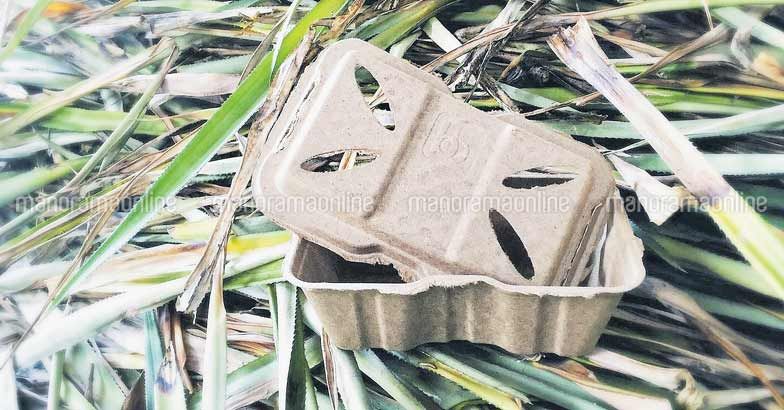
 ജക്കൂർ തിരുമനഹള്ളിയിലുള്ള ബയോല്യൂഷൻസ് പ്ലാന്റിനു മുന്നിൽ അസംസ്കൃത വസ്തുവായ കാർഷിക അവശിഷ്ടങ്ങൾ കൂട്ടിയിട്ടിരിക്കുന്നു.
ജക്കൂർ തിരുമനഹള്ളിയിലുള്ള ബയോല്യൂഷൻസ് പ്ലാന്റിനു മുന്നിൽ അസംസ്കൃത വസ്തുവായ കാർഷിക അവശിഷ്ടങ്ങൾ കൂട്ടിയിട്ടിരിക്കുന്നു. ബയോല്യൂഷൻസ് സ്ഥാപകനും സിഇഒയുമായ എഡ്വാർഡോ ഗോർഡീലോയ്ക്കൊപ്പം മാനേജിങ് ഡയറക്ടർ കുര്യൻ മാത്യു, ഡയറക്ടർമാരായ കുര്യൻ ജോർജ്, ജോർജ് തോമസ് എന്നിവർ.
ബയോല്യൂഷൻസ് സ്ഥാപകനും സിഇഒയുമായ എഡ്വാർഡോ ഗോർഡീലോയ്ക്കൊപ്പം മാനേജിങ് ഡയറക്ടർ കുര്യൻ മാത്യു, ഡയറക്ടർമാരായ കുര്യൻ ജോർജ്, ജോർജ് തോമസ് എന്നിവർ. ബോക്സുകൾക്ക് അന്തിമരൂപം നൽകുന്ന യന്ത്രം.
ബോക്സുകൾക്ക് അന്തിമരൂപം നൽകുന്ന യന്ത്രം. ബയോല്യൂഷൻസ് ഡിസ്പോസബിൾ ബോക്സുകളെക്കുറിച്ച് എം**ഡി കുര്യൻ മാത്യു വിശദീകരിക്കുന്നു. പിന്നിൽ ഡയറക്ടർ കുര്യൻ ജോർജ്.
ബയോല്യൂഷൻസ് ഡിസ്പോസബിൾ ബോക്സുകളെക്കുറിച്ച് എം**ഡി കുര്യൻ മാത്യു വിശദീകരിക്കുന്നു. പിന്നിൽ ഡയറക്ടർ കുര്യൻ ജോർജ്. തൃപ്പാക്കൽ ഗിരീഷ് കുമാർ തന്റെ വാഴത്തോട്ടത്തിൽ
തൃപ്പാക്കൽ ഗിരീഷ് കുമാർ തന്റെ വാഴത്തോട്ടത്തിൽ




